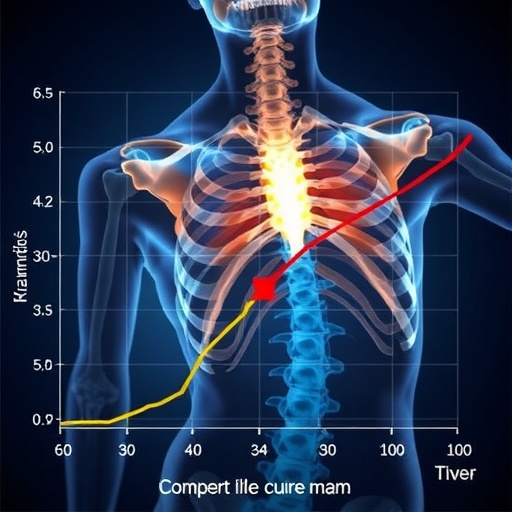Higher levels of belly fat are associated with lower vitamin D levels in obese individuals, according to data presented in Barcelona at the European Society of Endocrinology annual meeting, ECE 2018. The study reports that vitamin D levels are lower in individuals with higher levels of belly fat, and suggests that individuals, particularly the overweight with larger waistlines should have their vitamin D levels checked, to avoid any potentially health damaging effects.
Obesity is a global epidemic and contributes to an estimated 2.8 million deaths per year worldwide. Vitamin D deficiency is typically associated with impaired bone health but in recent years has also been linked with higher risks of acute respiratory tract infections, auto-immune diseases and cardiovascular diseases. Low vitamin D levels could therefore have wide-ranging and undetected adverse effects, although more research is required to confirm the role of vitamin D in these conditions. A link between low vitamin D levels and obesity has previously been reported but whether this effect is more associated with the type and location of fat was undetermined.
In this study Rachida Rafiq and colleagues from the VU University Medical Center and Leiden University Medical Center in the Netherlands examined how the amount of total body fat and abdominal fat measured in participants of the Netherlands Epidemiology of Obesity study related to their vitamin D levels. After adjusting for a number of possible influencing factors, including chronic disease, alcohol intake and levels of physical activity, they found that the amounts of both total and abdominal fat were associated with lower vitamin D levels in women, although abdominal fat had a greater impact. However, in men abdominal fat and liver fat, was associated with lower vitamin D levels. In all cases the greater the amount of belly fat, the lower the levels of detected vitamin D.
Rachida Rafiq comments, "Although we did not measure vitamin D deficiency in our study, the strong relationship between increasing amounts of abdominal fat and lower levels of vitamin D suggests that individuals with larger waistlines are at a greater risk of developing deficiency, and should consider having their vitamin D levels checked."
The researchers now plan to investigate what may underlie this strong association between vitamin D levels and obesity – whether a lack of vitamin D is predisposing individuals to store fat, or whether increased fat levels are decreasing vitamin D levels is not yet clear. However, this research points to a more important role for abdominal fat in the relationship, and a place to focus future studies on.
As Rachida Rafiq says, "Due to the observational nature of this study, we cannot draw a conclusion on the direction or cause of the association between obesity and vitamin D levels. However, this strong association may point to a possible role for vitamin D in abdominal fat storage and function."
###
Abstract
OC6.5
Associations of different body fat deposits with serum 25-hydroxyvitamin D concentrations
Rachida Rafiq¹, Floor Walschot¹, Paul Lips¹, Hildo Lamb², Albert de Roos², Frits Rosendaal², Martin den Heijer1,2, Renate de Jongh¹, Renée de Mutsert²
¹VU University Medical Center, Amsterdam, Netherlands. ²Leiden University Medical Center, Leiden, Netherlands.
Introduction
Overall and abdominal obesity are both well-established risk factors of vitamin D deficiency. However, it is unclear which fat depot is most strongly related to serum 25-hydroxyvitamin D (25(OH)D) concentrations.
Objective
This study aims to distinguish specific contributions of total body fat, abdominal subcutaneous adipose tissue (aSAT), visceral adipose tissue (VAT) and hepatic fat on 25(OH)D concentrations.
Methods
This study is a cross-sectional analysis of the baseline measurements of the Netherlands Epidemiology of Obesity study, a population-based cohort study in men and women aged between 45 and 65 years. We used linear regression analyses to examine associations of total body fat, aSAT, VAT (n=2441) and hepatic fat (n=1980) with serum 25(OH)D concentrations. In the analyses we adjusted for age, ethnicity, education, chronic diseases, smoking, alcohol consumption and physical activity. Standardized values were used to compare the different adiposity measures.
Results
Mean (SD) age and serum 25(OH)D concentrations of the study population was 56 (6) years and 70.8 (24.2) nmol/L, respectively. Total body fat was inversely associated with 25(OH)D concentrations in women, but not in men. One percent higher total body fat was associated with 0.40 nmol/L (95%CI: -0.67 to -0.13) lower 25(OH)D. VAT was inversely associated with serum 25(OH)D concentrations in both men and women. One cm2 higher VAT was associated with 0.05 nmol/L (-0.09 to -0.02) lower 25(OH)D in men, and 0.06 nmol/L (-0.10 to -0.01) lower 25(OH)D in women. Hepatic fat was only associated with 25(OH)D in men. A tenfold increase in hepatic fat was associated with 6.21 nmol/L (-10.70 to -1.73) lower 25(OH)D. aSAT was not associated with 25(OH)D concentrations in both men and women. Regressions with standardized values showed VAT was most strongly related to serum 25(OH)D concentrations.
Conclusions
The relationship between different adiposity measures and 25(OH)D concentrations was different for men and women. In women, total body fat and VAT were inversely related to 25(OH)D concentrations. In men, VAT and hepatic fat were related to 25(OH)D concentrations. In both men and women, VAT was most strongly associated with 25(OH)D concentrations. This implies that specific attention for vitamin D deficiency should be given to individuals with a high amount of VAT.
Media Contact
Aida de Heras
[email protected]
145-464-2206
http://www.euro-endo.org/




